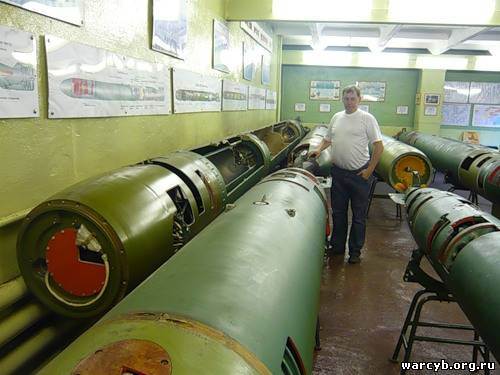Type 65-76 Kit
Overview

Type 65-73
A Type 65-76A torpedo in a museum against the wall with cut outs to show internal components.
Source: www.warcyb.org -
© copyright lies with original owner
1991 for Type 65-76A
1975 - 1976 (Soviet state trials)
1985 - 1986 (Type 65-76A)
Russian for "whale"
Type 65 (NATO reporting name)
Izdeliye 298 (article index)
Russia
Description
Introduction
The Type 65-76 torpedo is a very large Cold War era torpedo of Soviet origin. Due to their size the use of these weapon was limited to only a very few types of submarines. The Type 65 is one of the most capable anti-ship torpedoes in existence as it has a very high speed, a very long range and a very powerful payload. The Type 65 is also a very dangerous weapon system that needs to be handled with care due to its hydrogen peroxide fuel. A Type 65 torpedo has been blamed for the explosion that sunk the Russian Kursk nuclear powered missile submarine.
Design
The Type 65 may have started out as an up-scaled Type 53-65K torpedo. The Type 65 has a diameter of 650mm and a length of over 11 meters. Development started at the same time as the Type 65-73, which entered service earlier since as a non-homing torpedo it required less development. The wake homing seeker is located in the nose with the warhead directly behind it. The fuel and turbine engine make up most of the center. The use of high test peroxide fuel provides a lot of power, with the drawback of being highly volatile. Unusually the guidance section is in the rear. The two contra-rotating propellers are encased by control planes.
Guidance
The Type 65-76 is intended for use against surface vessels and uses acoustic wake homing. This method of homing is very difficult to jam. Inertial navigation by means of gyroscopes is used to guide the weapon to a position where the wake can be picked up. The Type 65-73A with improved signal processing capabilities was introduced in the early 1990's.
Firepower
The Type 65-76 torpedo has a warhead of at least 450 kg, making it powerful enough to sink an aircraft carrier with only one torpedo. The warhead has both impact and proximity fuses. Maximum range is about 50 km at its 50 kt maximum speed, or about 100 km at a slower pace of 30 kt.
Launch platforms
Type 65-76 torpedoes are solely used on Soviet/Russian submarines. Due to its size the 650mm torpedoes are only used on large submarines. Several Soviet SSN and SSBN designs since 1972 feature 650mm torpedo tubes, alongside 533mm torpedo tubes. Recent Russian submarines no longer feature 650mm tubes, slowly marking the end for this type of torpedo. Use on surface ships and coastal defense launchers has been proposed but haven't materialized.
Users
The Type 65-76 torpedo is only used by USSR, with all transferred to Russia. The accident with the Kursk led all Type 65's to be stored. However, they remained in limited use by 2019 and possibly today. Variants of 650mm torpedoes have been offered for export. There are reports that China adopted Type 65 technology, but 650mm torpedoes are currently not in use with the Chinese navy.